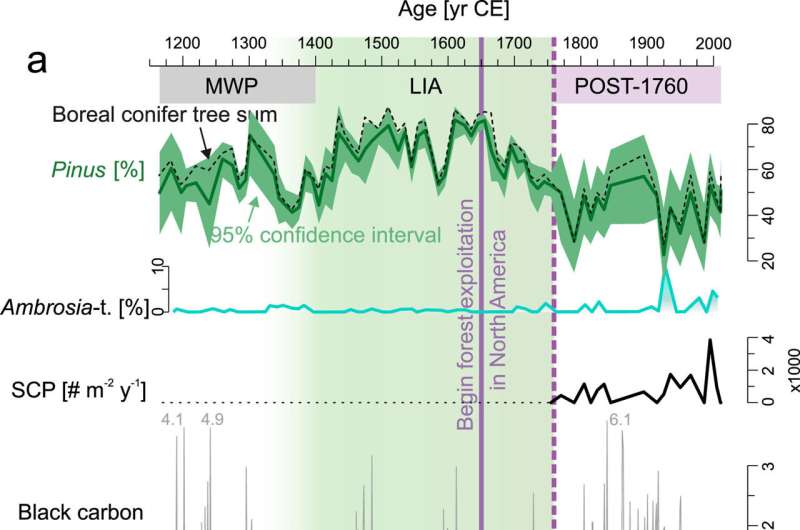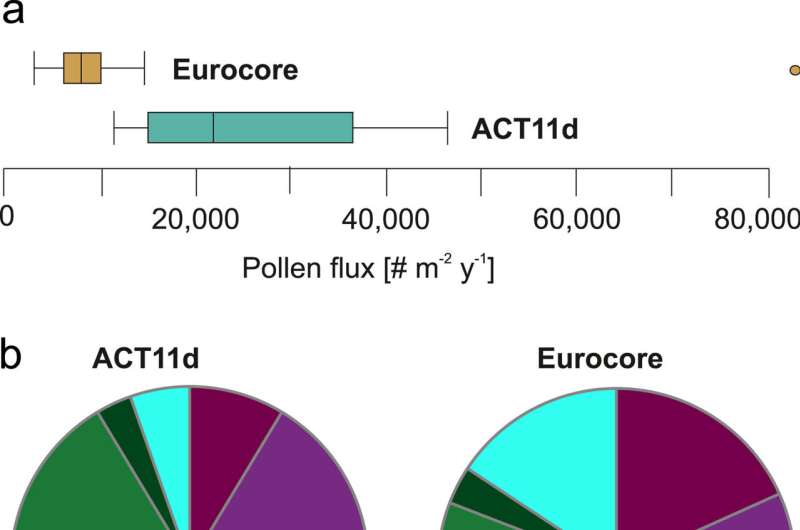January 29, 2024 feature
This article has been reviewed according to Science X's editorial process and policies. Editors have highlighted the following attributes while ensuring the content's credibility:
fact-checked
peer-reviewed publication
trusted source
proofread
Pollen diaries: Polar ice records preserve climate vs. human impact following Little Ice Age

Pollen can help scientists track changes in vegetation through time, as they respond to moderations of the climate, be that glaciation or deglaciation with transitions into and out of ice ages. Furthermore, it can help elucidate the interplay between climate and the impact early human settlement exploitation of the natural world had on forests.
Dispersal of pollen has evolved diverse mechanisms over millennia and can be carried over distances of hundreds to thousands of kilometers. Indeed, modeling shows that ice cores taken from southern Greenland preserve boreal and mixed-conifer forest pollen derived from >3,500 km away in eastern Canada at a resolution of five to 20 years.
New research, published in Geophysical Research Letters, has generated an 850-year pollen record (including the Medieval Warm Period, ~950–1350 CE, and Little Ice Age, ~1350–1750 CE) from Greenland to determine the role of climate and humans in modifying boreal ecosystems, particularly high-latitude regions most susceptible to warming.
Dr. Sandra Brugger, of the Desert Research Institute, U.S., and colleagues used advanced techniques to isolate pollen from an archived ice core recovered at 2,120 m above sea level in 2011. Individual pollen grains were counted and identified under a light microscope at 400x magnification, indicative of their microscopic size. Additionally, the presence of spheroidal carbonaceous particles is a key marker for human occupation in the ice cores, being a distinct form of black carbon derived from burning fossil fuels.
Within the investigation, the scientists identified 111 pollen taxa in the ice core, with many being single occurrences, a characteristic of high-elevation ice cores that record a wide catchment area from wind-blown pollen grains and other aerosols. However, the more abundant taxa of boreal conifers included pine (Pinus), spruce (Picea), fir (Abies) and larch (Larix), while ragweed (Ambrosia) was used as an indicator of landscape disturbance as it is a flowering plant growing in clearings.

The research team identified distinct changes in boreal forest pollen coincident with the transition from the Medieval Warm Period to the Little Ice Age, with increases in pine, spruce, fir and birch (together comprising ~80% of the pollen assemblage at ~1400 CE) during the onset of this glacial event, when climate overall became cooler and drier.
Pine's proliferation in particular is important as it is a pioneer species, meaning it is one of the first to colonize relatively barren landscapes, and so likely expanded into wetland areas that were drying up as the Little Ice Age got underway. This coniferous pollen is linked to lakes in southern Québec and Ontario, which today are surrounded by mixed conifer forests.
Subsequently, the record shows a noticeable decline in conifer pollen to ~40% from ~1650 CE, but this occurred while Little Ice Age conditions continued/proliferated, so Dr. Brugger and colleagues instead suggest that human impact from exploiting the forest for firewood and farming was having a much more noticeable effect.
This continued through to ~1760 CE, when a significant change in pollen towards that of the comparatively modern 20th century occurred. Here, pine dominated the pollen grains (~43%), while spruce and birch (Betula) were present in only small abundances of ~2-3%.
The remainder of the assemblage composition comprised tundra shrubs and herbaceous plants, which together indicates tree logging to produce clearings where weeds like Ambrosia could grow, thus human impact outweighed that of climate in the northern hemisphere.
Previous research in eastern Canada has supported this with evidence for a decline in white pine as it was a major target for timber exploitation by European settlers, so much so that by 1850 CE most of it had been irrevocably harvested in the region.
Following the termination of the Little Ice Age, as warming began, the research team did not identify a coincident increase in boreal conifers, as might be expected if the landscape was being modulated by climate alone. Instead, a combination of continuing permafrost, wetland expansion and human-induced logging may have kept pine abundances low post-1760 CE.
This research is important as climate change continues to rapidly alter Arctic ecosystems, with plant species migrating northwards into ever-warmer ecological niches. Such polar warming is exacerbated by positive feedback mechanisms, like ice-albedo, whereby melting ice caps and glaciers reduce the 'white' surface to reflect incoming solar radiation, thus comparatively 'darker' ocean and land absorbs more solar radiation and warms the ambient environment, leading to enhanced ice melt and so the loop continues.
Dr. Brugger and colleagues therefore suggest that such feedbacks prolong droughts in high latitude regions, increasing the risk of forest fires and biomass burning, which in turn contribute more carbon dioxide to the atmosphere and enhance global warming. It is unlikely that our boreal forests will return to the once-thriving ecosystems prior to the northern expansion of settlements since the Medieval Warm Period and modern industrialization.
More information: Sandra O. Brugger et al, Pollen in Polar Ice Implies Eastern Canadian Forest Dynamics Diverged From Climate After European Settlement, Geophysical Research Letters (2024). DOI: 10.1029/2023GL105581
Journal information: Geophysical Research Letters
© 2024 Science X Network




















